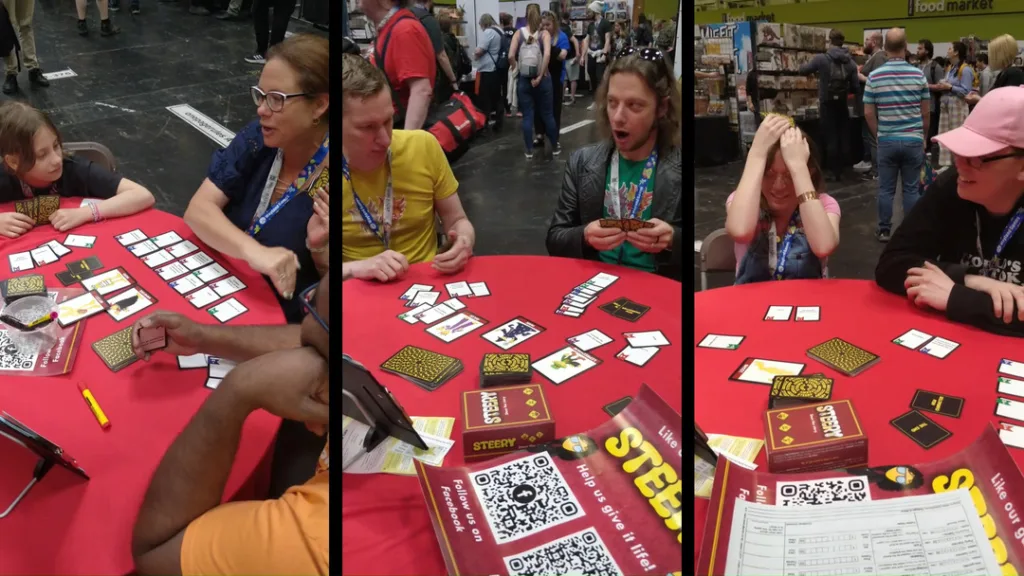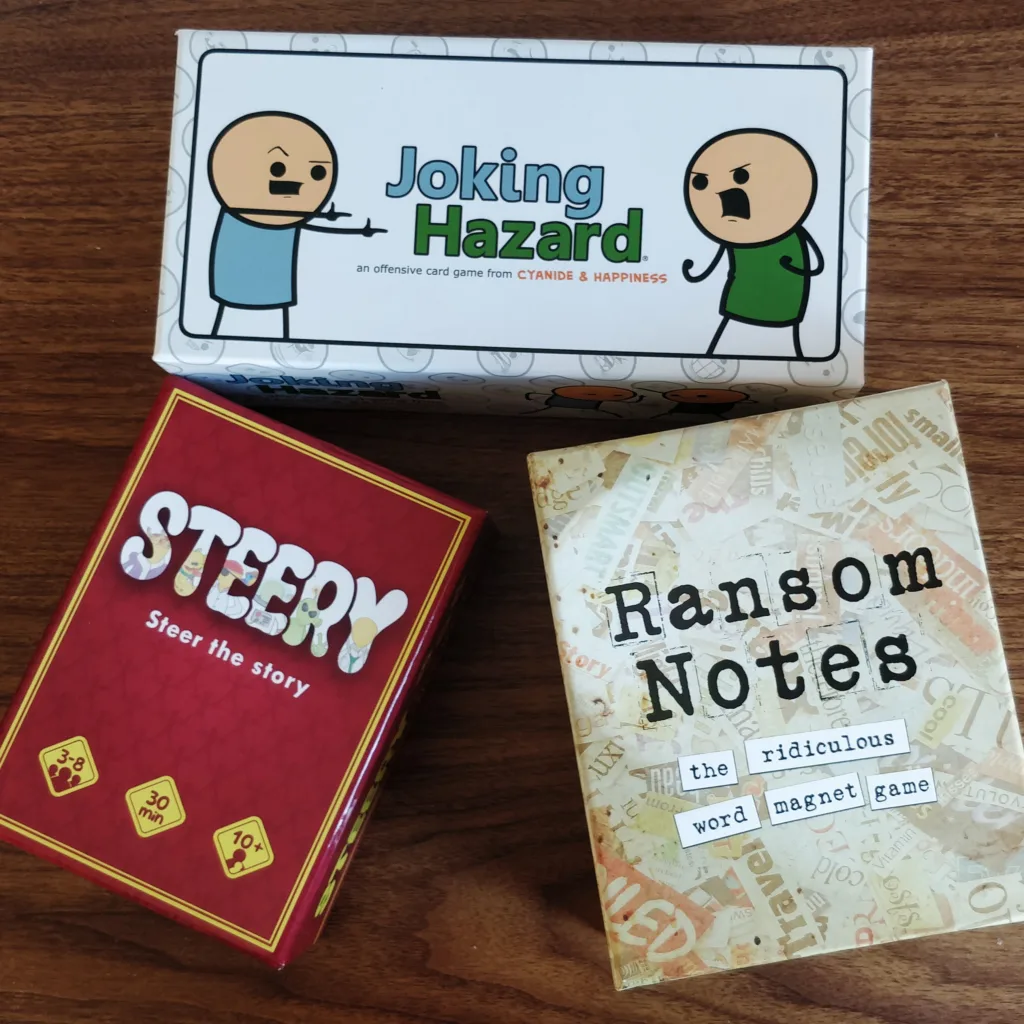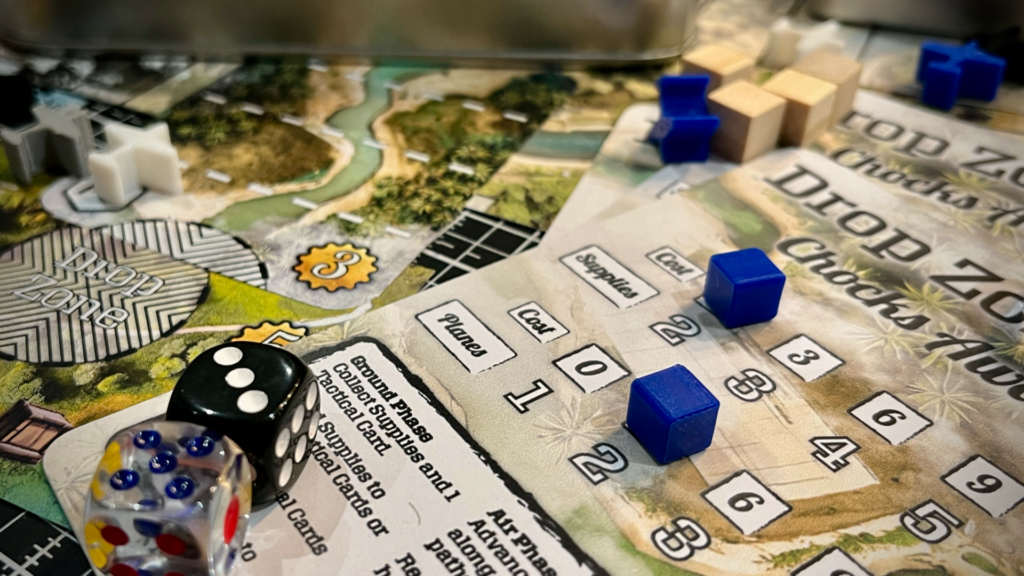In a world filled with tabletop experiences, what makes a truly great party game? That’s the question we’re tackling today with STEERY co-creator Irina, as we delve into the mechanics and magic behind memorable game nights. From the social dynamics that fuel player interaction to the delicate balance between structure and creative freedom, we explore what defines the party game genre—and how STEERY aims to carve its unique niche within it.
Join us for a conversation about surreal storytelling, competitive collaboration, and the journey from concept to Kickstarter ahead of their April 29th launch. Game designers and enthusiasts alike will find plenty to ponder here – at the end, please lets us know what you think makes a great party game!
Joe: Welcome back Irina. As you’ve been here before, people can check out your previous blog post about Storytelling. But for the new folk, can you give us an introduction – who are you, and what are you up to?
Irina: Hi, Joe! Really excited to be back! Irina here, co-creator of STEERY. My husband Sam and I have been working on STEERY for about 3 years, and right now we are adding the finishing touches on our Kickstarter campaign launching really soon – 29th of April 2025!

As for our game, we like to say STEERY is the party game of surreal humour and storytelling mayhem. Players take turns to steer a story they’re building as a group, but they score points individually for their contribution to the narrative. The player with the most points wins. The deck also includes special cards that prompt the players to end the story or add new characters when they least expect – just in case the game wasn’t chaotic enough already!
What kind of games do you usually play, and what do you appreciate the most about that genre?
Joe: I’ll play anything anyone puts in front of me, I’m really not picky. Some of the heavier euro games I have to psych myself up for, and there’s some party games that I don’t enjoy much, but I’m always up for giving things a try.
As STEERY is a party game at heart, let’s explore that a little. What is a party game?
Irina: Let’s look at the most popular party games on Board Game Geek and try to break it down this way. On that list we see big names such as Exploding Kittens, Dixit, Coup, Cards Against Humanity, Codenames, Just One, and so, so many more. Having played many of these games, I can see a few features they have in common:
- They’re quick to learn and to set up: after roughly 10 minutes of learning it and 5 minutes of setting it up, you’re all ready to go.
- They support (and even encourage) large groups: most party games allow groups as large as 8 players, and not a lot of them have a 2-player mode.
But this sounds very technical, very focused on game design. How do party games generally feel?
The main focus of the players is the activity they’re engaged in, rather than the competition. For example, in a player-judge game (such as Joking Hazard), you rarely end the game when a player has scored enough votes to win. Instead, you keep playing to see what other ridiculous comic strips you can create.
“The best party games have a high level of player interaction, whether it’s about calling each other’s bluff, building something together or sabotaging the absolute hell out of each other.”
They are social games. The best party games have a high level of player interaction, whether it’s about calling each other’s bluff, building something together or sabotaging the absolute hell out of each other.
A big chunk of them aim to be a humorous experience. Some games come with in-built comical card design or content, others bring out the comedians in the players. Some games have a mix of both.
These are the things we see and appreciate in the party games we play, at least. We like it when the game we play is secondary to the experience of bonding with everyone else around the table. And party games are great for that.
What about yourself? You mentioned there are some party games you don’t enjoy much. Would you like to talk about what exactly in those games puts you off? And perhaps what you appreciate in a party game?
Joe: Social deduction games – it’s a personal preference but I really don’t enjoy the experience of being part of them. I’m not great at lying, and I don’t so much enjoy the experience of being lied to! There are some games though that I love, for example Don’t Get Got. I love the idea of a game played out whilst other things are going on; a game that runs in the background is fun.
There’s a game called Killer (it’s been around in various guises over the year in published forms) that I play when I’m working on Summer Camps. Everyone’s name goes in a hat, and an object and location per player is written on separate pieces also. Each player picks one of each out. To ‘kill’, you need to find the person on your card, take them to the location and make them hold the item. If you do, they’re out and you claim their mission. I usually play over the course of a couple of days. It’s so much fun.
Since we’re on the subject of favourites, what’s your favourite party game?
Irina: Ah, that’s a tough one, it’s really difficult to choose just one. The party game that started it all was Joking Hazard, the Cyanide and Happiness game. It had been my number one for years, and I think a big reason for it was how much it was making us all laugh every single time we played it. There was no game that could beat that. After being exposed to many other games over the years, I started to appreciate the games that allowed for a bit more creative freedom. Sure, you need to be creative enough to connect the dots and select the card that adds the perfect punch line to the comic strip, but wouldn’t it be even cooler to create your own punch line? And that’s what I’ve been looking for in the new games that I try. That’s what drove the creation of STEERY. Lately I bring Ransom Notes from Big Potato to every social gathering; it might just be my new favourite party game. I love how it gives you just enough to write the most ridiculous and comical ransom notes; it’s always a good laugh.

Neither Joking Hazard nor Ransom Notes have particularly high player interaction (being designed around a player-judge mechanic), but they tick all the other boxes. And I think they have one additional thing in common that particularly intrigues me: you get a glimpse into the other players’ minds! What memories/feelings does a particular prompt/illustration trigger? What does the card make them think of and how does that reflect on their creation? You can learn a lot about someone just by looking at how they interact with the concepts inside the game and what they build with them. You can learn so much about a person from social deduction games too, but that’s for another day.
How do you feel about using games as a tool to get to know people on a personal level? Do you think there’s a better game category for it than party games?
Joe: That’s a really good question. I think all games have the potential to bring people together, begin or strengthen relationships and allow you to get to know people in a new way.
Party games do this, but to a much greater extent. A well-designed party game can tick so many boxes and really elevate an evening with friends. What I enjoy about them is that they are performance pieces, often crafted in minutes of heavily improvised work. I have a background in theatre and I love the madness, wonder and insight that can spill out of our heads into the room and create moments of excitement, wonder or laughter.
Tell me about STEERY – what mechanics does it use so that it works as such an ace party game?
Irina: We’ve had a lot of great feedback about the blend of collaboration and competition in STEERY, and I think we’ve really nailed the sweet spot there. The story cards having associated points really helps in getting the ball rolling, because players tend to play them at the beginning of the story and score the big points from the start. The player with the most points at the end of the game wins, right? So you have to aim for that. But as the story progresses, players just feel so involved in the narrative that the scoring system becomes secondary, and all that matters is pushing the story forward with the prompts on their cards. By the end of the story players usually forget that they’re supposed to achieve the highest score. Nevertheless, once a story ends they’re usually excited and curious to go and count their points. There will be only one winner most times, but everyone will be cheering and celebrating because the story they built together was rewarding in itself. We are extremely proud of STEERY for being able to immerse its players in the moment the way that it does.
We like it when the game we play is secondary to the experience of bonding with everyone else around the table. And party games are great for that.
But of course there will always be players who keep their eyes on the prize: scoring the most points. It is a game after all; that’s how you win. And highly competitive players such as them will usually (very confidently) try to bend the narrative in the most creative but outlandish ways possible just to fit their high point cards in. And whether that’s acceptable or not is really down to the rest of the group. If everyone else believes a player is really reaching with their storytelling, they can all vote to reject it, which is where the voting mechanism comes into play. And we didn’t add voting to the game just to make sure stories don’t go too much off the rails, but because it also increases the level of player interaction significantly. Every time a player is challenged, they have a second chance to justify their contribution and convince the group that it works; they have to answer questions and build their case before the group votes them down. It’s particularly funny when the challenged player is a social deduction games fan too; they usually manage to weasel their way out of the objection easily.
I think these are the main mechanisms that make STEERY what it is. If you were to design a party game, how would you go about it?
Joe: Very slowly – I’d struggle to find playtesters at large numbers! But in seriousness, the game I described above, Killer, that would make an ace party game. So the answer to your question would be to lean on games that I know might have potential that I’ve already played. I mentioned working on Summer Camps, and through those I have a wide repertoire of ‘party-ish’ style games. There are plenty of those that would translate quite nicely.
STEERY is going live very soon – can you let us know how you’re feeling this close to launch?
Irina: Ha, there is so much going on that even we don’t know how we’re feeling! We are excited that our game will finally become publicly available in less than a week. On the other hand, we often question ourselves if we’re really ready, if we have a big enough crowd to back us up. At the same time, we feel hopeful when we see so many people enjoy playing STEERY and share the love on social media. Nevertheless, the anxiety creeps in a bit when we remember how new we are to this, and how easy it is to miss important things. We are pumped to get everything ready for the Kickstarter and we’re putting a lot of work into that at the moment, while also trying to keep an eye on our mental health and stress levels. It’s huge, most likely our biggest venture yet, but we are having so much fun in the process, learning tons of new things and constantly meeting amazing people.
It’s huge, most likely our biggest venture yet, but we are having so much fun in the process, learning tons of new things and constantly meeting amazing people.
In short, mixed feelings. We try to deal with them by telling ourselves that whatever happens during our campaign, the whole journey was a positive experience. What do you do when you’re overwhelmed by a mishmash of feelings? How do you deal with them?
Joe: I’m not sure I have a decent answer to that. I try my best to slow down; so often we think there’s a pressure to do something quickly, when actually there’s plenty of time to sit back, take a breath and think. I also try to not get myself into situations where I am blindsided by anything; this means careful planning beforehand to make sure I’m ahead of as many of the foreseeable possibilities as I can be.
Let’s round this out with one final question, tell the readers how they can support your game.
Irina: The best thing you can do to support STEERY is spread the word about it. If you’re excited about our game, chances are your friends might be too. So bring up STEERY at your next board game night and engage with us on social media!
If you have a Kickstarter account, head over to our Kickstarter page and click the “Notify me on launch” button to be the first to know when we go live. Having you on our mailing list is also a great boost, and you still have a few days left before launch to join and claim your free exclusive character card!
Thank you, Joe, and everyone else reading this. And never stop telling stories 🙂
I’m super excited about catching STEERY on Kickstarter this month (starts 29.4.25), if you are too, then please find the game here. Make sure to follow STEERY on Instagram too.
Irina and I would like to know from you – what makes a great party game? Can you answer in the comments below (it’ll be much better than the marketing spam I usually get in the comments).
Finally, subscribe to the blog, you know you want to, and you know it’ll make me happy.


